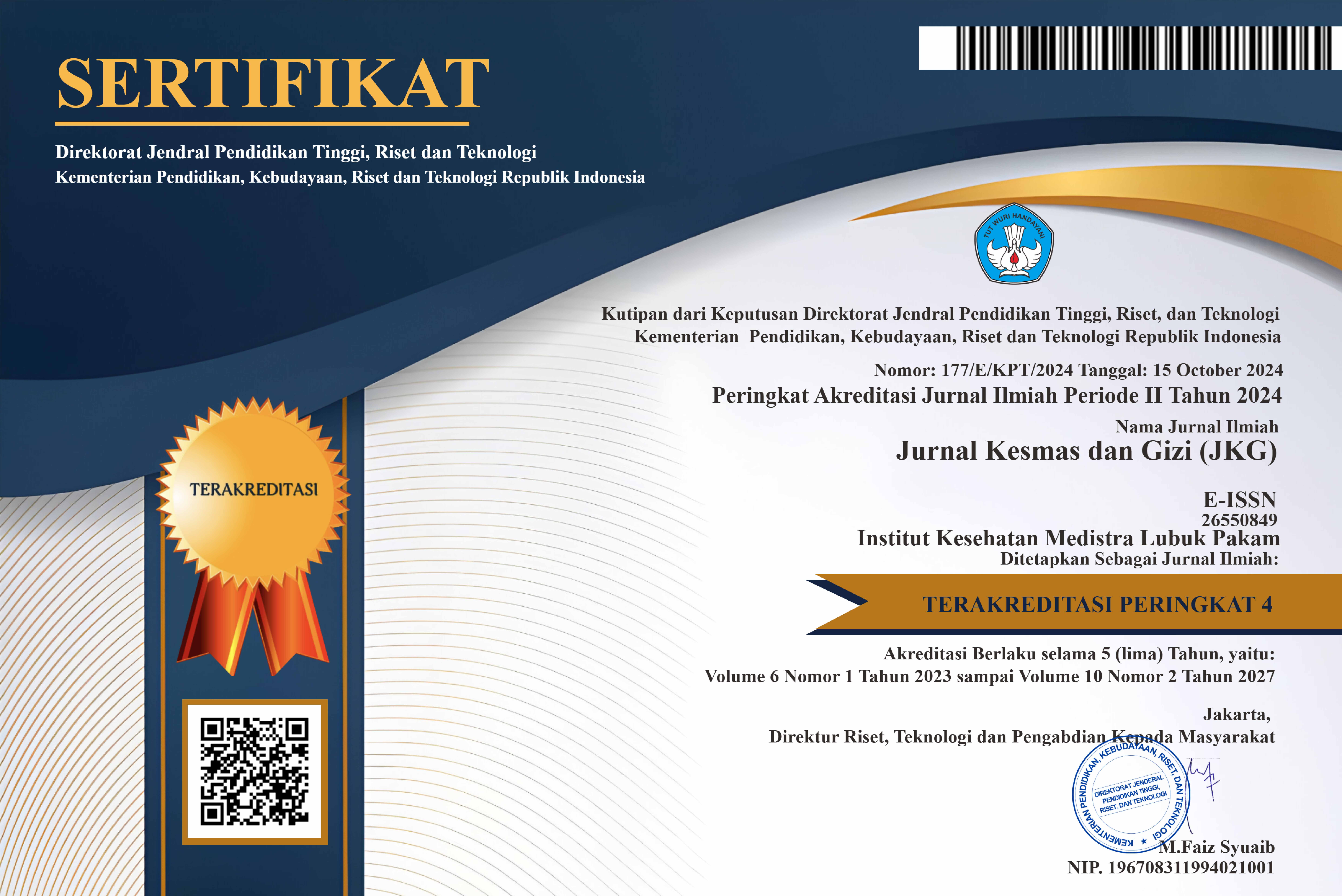Determinants of the Utilization of Electronic Medical Record (EMR) Systems by Healthcare Human Resources at Grandmed Hospital
DOI:
https://doi.org/10.35451/vqeek196Keywords:
Electronic Medical Record, health personnel, , hospital management, digital health, implementation strateAbstract
The implementation of Electronic Medical Records (EMR) has become one of the most significant innovations in health services, aiming to enhance efficiency, effectiveness, and quality of care in hospitals. This study seeks to analyze the determinants that influence the utilization of EMR by health personnel at Grandmed Hospital. Using a quantitative approach with a cross-sectional design, the study involved health workers as respondents to identify factors such as training, technical support, user perception, and system usability that affect the successful implementation of EMR. The findings indicate that adequate training, positive user perception, and strong management support significantly contribute to the optimal use of EMR. Furthermore, system design that aligns with workflow is also proven to reduce resistance and improve acceptance among health personnel. These results highlight that the successful implementation of EMR is not merely a matter of technology, but also requires readiness of human resources, supportive policies, and continuous evaluation to ensure its sustainability. This research is expected to serve as a reference for hospital management in strengthening EMR implementation strategies, so that the benefits of EMR can be maximized, including improving patient safety, streamlining clinical and administrative processes, and supporting data-based decision-making. Ultimately, strengthening these factors is an important step in achieving quality digital health services that are sustainable and adaptive to technological developments
Downloads
References
[1] Z. A. Golo, A. Fahyudi, A. A. Ilyas, and T. Santika, “Implementation of Electronic Medical Records at Primary Care in Semarang City Region: An Analysis of Individual and Organisational Determinants,” J. Penelit. Pendidik. IPA, vol. 9, no. 11, pp. 9985–9991, 2023, doi: 10.29303/jppipa.v9i11.5627.
[2] S. A. Amrullah, “Factors Influencing the Implementation of Electronic Medical Records (EMR) Using the Human, Organization, and Technology Fit (HOT-Fit) Approach,” no. 24, pp. 10–17, 2025.
[3] P. S. Damayanti, I. M. S. Adiputra, and I. G. A. N. P. Pradnyantara, “Tantangan penerapan Rekam Medis Elektronik (RME) berdasarkan regulasi Permenkes No. 24 Tahun 2022,” Heal. Sci. Pharm. J., vol. 9, no. 1, pp. 47–55, 2025, doi: 10.32504/hspj.v9i1.1164.
[4] A. De Benedictis, E. Lettieri, L. Gastaldi, C. Masella, A. Urgu, and D. Tartaglini, “Electronic medical records implementation in hospital: An empirical investigation of individual and organizational determinants,” PLoS One, vol. 15, no. 6, pp. 1–12, 2020, doi: 10.1371/journal.pone.0234108.
[5] K. C. Derecho et al., “Technology adoption of electronic medical records in developing economies: A systematic review on physicians’ perspective,” Digit. Heal., vol. 10, no. 2, 2024, doi: 10.1177/20552076231224605.
[6] Fita Rusdian Ikawati and M. Syauqi Haris, “Challenges in Implementing Digital Medical Records in Indonesian Hospitals: Perspectives on Technology, Regulation, and Data Security,” Proceeding Int. Conf. Inov. Sci. Technol. Educ. Child., vol. 4, no. 2, pp. 01–25, 2024, doi: 10.62951/icistech.v4i2.70.
[7] M. K. Hossain, J. Sutanto, P. W. Handayani, A. A. Haryanto, J. Bhowmik, and V. Frings-Hessami, “An exploratory study of electronic medical record implementation and recordkeeping culture: the case of hospitals in Indonesia,” BMC Health Serv. Res., vol. 25, no. 1, 2025, doi: 10.1186/s12913-025-12399-0.
[8] C. H. Tsai, A. Eghdam, N. Davoody, G. Wright, S. Flowerday, and S. Koch, “Effects of electronic health record implementation and barriers to adoption and use: A scoping review and qualitative analysis of the content,” Life, vol. 10, no. 12, pp. 1–27, 2020, doi: 10.3390/life10120327.
[9] S. Musa, I. Dergaa, R. A. S. Yasin, and R. Singh, “The Impact of Training on Electronic Health Records Related Knowledge, Practical Competencies, and Staff Satisfaction: A Pre-Post Intervention Study Among Wellness Center Providers in a Primary Health-Care Facility,” J. Multidiscip. Healthc., vol. 16, no. March, pp. 1551–1563, 2023, doi: 10.2147/JMDH.S414200.
[10] D. E. Yehualashet, B. T. Seboka, G. A. Tesfa, A. D. Demeke, and E. S. Amede, “Barriers to the adoption of electronic medical record system in ethiopia: A systematic review,” J. Multidiscip. Healthc., vol. 14, pp. 2597–2603, 2021, doi: 10.2147/JMDH.S327539.
[11] R. M. Rahal, J. Mercer, C. Kuziemsky, and S. Yaya, “Factors affecting the mature use of electronic medical records by primary care physicians: a systematic review,” BMC Med. Inform. Decis. Mak., vol. 21, no. 1, pp. 1–15, 2021, doi: 10.1186/s12911-021-01434-9.
[12] S. Upadhyay and H. F. Hu, “A Qualitative Analysis of the Impact of Electronic Health Records (EHR) on Healthcare Quality and Safety: Clinicians’ Lived Experiences,” Heal. Serv. Insights, vol. 15, 2022, doi: 10.1177/11786329211070722.
[13] N. F. Fauziyah et al., “Kepuasan Pengguna Terhadap Penggunaan Rekam Medis Elektronik Di Rumah Sakit Swasta: Studi Cross Sectional,” Heal. Inf. J. Penelit., vol. 17, no. 1, pp. 42–50, 2025, doi: 10.36990/hijp.v17i1.1613.
[14] J. Campione and H. Liu, “Perceptions of hospital electronic health record (EHR) training, support, and patient safety by staff position and tenure,” BMC Health Serv. Res., vol. 24, no. 1, pp. 1–11, 2024, doi: 10.1186/s12913-024-11322-3.
[15] R. M. Elektronik, “Pada,” vol. 8, no. 3, pp. 617–625, 2024.
[16] A. Boonstra and M. Broekhuis, “Barriers to the acceptance of electronic medical records by physicians from systematic review to taxonomy and interventions,” BMC Health Serv. Res., vol. 10, 2010, doi: 10.1186/1472-6963-10-231.
[17] N. K. Mensah et al., “Health professionals’ perceptions of electronic health records system: a mixed method study in Ghana,” BMC Med. Inform. Decis. Mak., vol. 24, no. 1, 2024, doi: 10.1186/s12911-024-02672-3.
[18] T. A. Bekele et al., “Barriers and facilitators of the electronic medical record adoption among healthcare providers in Addis Ababa, Ethiopia,” Digit. Heal., vol. 10, 2024, doi: 10.1177/20552076241301946.
[19] H. Abbasi, B. Rahimi, M. Jebraeily, and A. Nourani, “End-users’ perspectives on factors affecting implementation and utilization of the Iranian electronic health record system: a qualitative study in a developing country,” BMC Health Serv. Res., vol. 23, no. 1, pp. 1–9, 2023, doi: 10.1186/s12913-023-10033-5.
[20] A. L. Kurniawan and M. Arini, “Effectiveness and User Satisfaction of Electronic Medical Records in Indonesia Private Hospital,” South East. Eur. J. Public Heal., vol. XXV, pp. 1128–1138, 2024, doi: 10.70135/seejph.vi.2363.
Downloads
Published
Issue
Section
License
Copyright (c) 2025 Reni Aprinawaty Sirait, Judika Silaban

This work is licensed under a Creative Commons Attribution 4.0 International License.
Copyright in each article is the property of the Author.


























